NISSAN X-TRAIL 2003 Electronic Repair Manual
Manufacturer: NISSAN, Model Year: 2003, Model line: X-TRAIL, Model: NISSAN X-TRAIL 2003Pages: 3066, PDF Size: 51.47 MB
Page 2511 of 3066
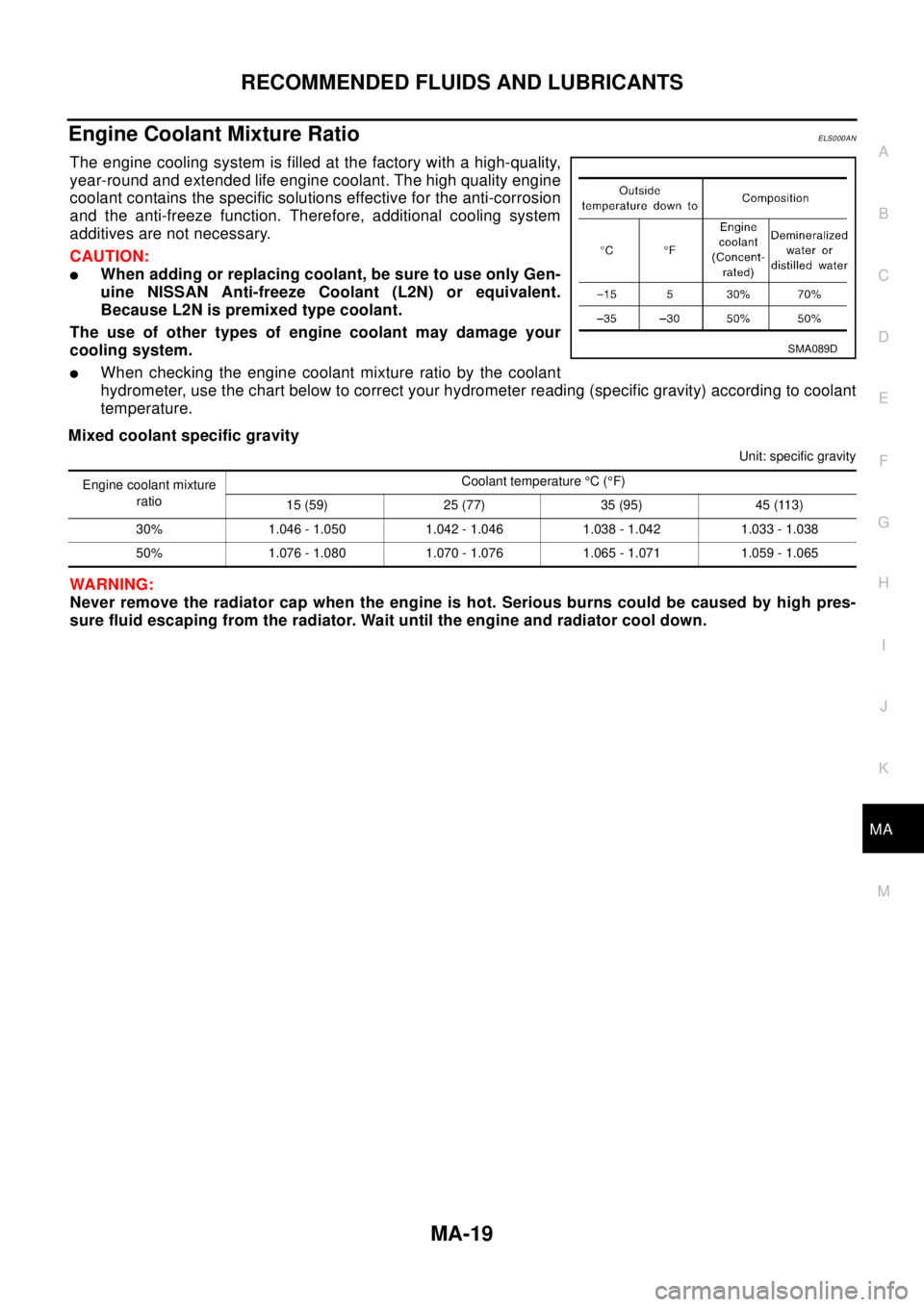
RECOMMENDED FLUIDS AND LUBRICANTS
MA-19
C
D
E
F
G
H
I
J
K
MA
B
MA
Engine Coolant Mixture RatioELS000AN
The engine cooling system is filled at the factory with a high-quality,
year-round and extended life engine coolant. The high quality engine
coolant contains the specific solutions effective for the anti-corrosion
and the anti-freeze function. Therefore, additional cooling system
additives are not necessary.
CAUTION:
lWhen adding or replacing coolant, be sure to use only Gen-
uine NISSAN Anti-freeze Coolant (L2N) or equivalent.
Because L2N is premixed type coolant.
The use of other types of engine coolant may damage your
cooling system.
lWhen checking the engine coolant mixture ratio by the coolant
hydrometer, use the chart below to correct your hydrometer reading (specific gravity) according to coolant
temperature.
Mixed coolant specific gravity
Unit: specific gravity
WA RN ING:
Never remove the radiator cap when the engine is hot. Serious burns could be caused by high pres-
sure fluid escaping from the radiator. Wait until the engine and radiator cool down.
SMA089D
Engine coolant mixture
ratioCoolant temperature°C(°F)
15 (59) 25 (77) 35 (95) 45 (113)
30% 1.046 - 1.050 1.042 - 1.046 1.038 - 1.042 1.033 - 1.038
50% 1.076 - 1.080 1.070 - 1.076 1.065 - 1.071 1.059 - 1.065
Page 2512 of 3066
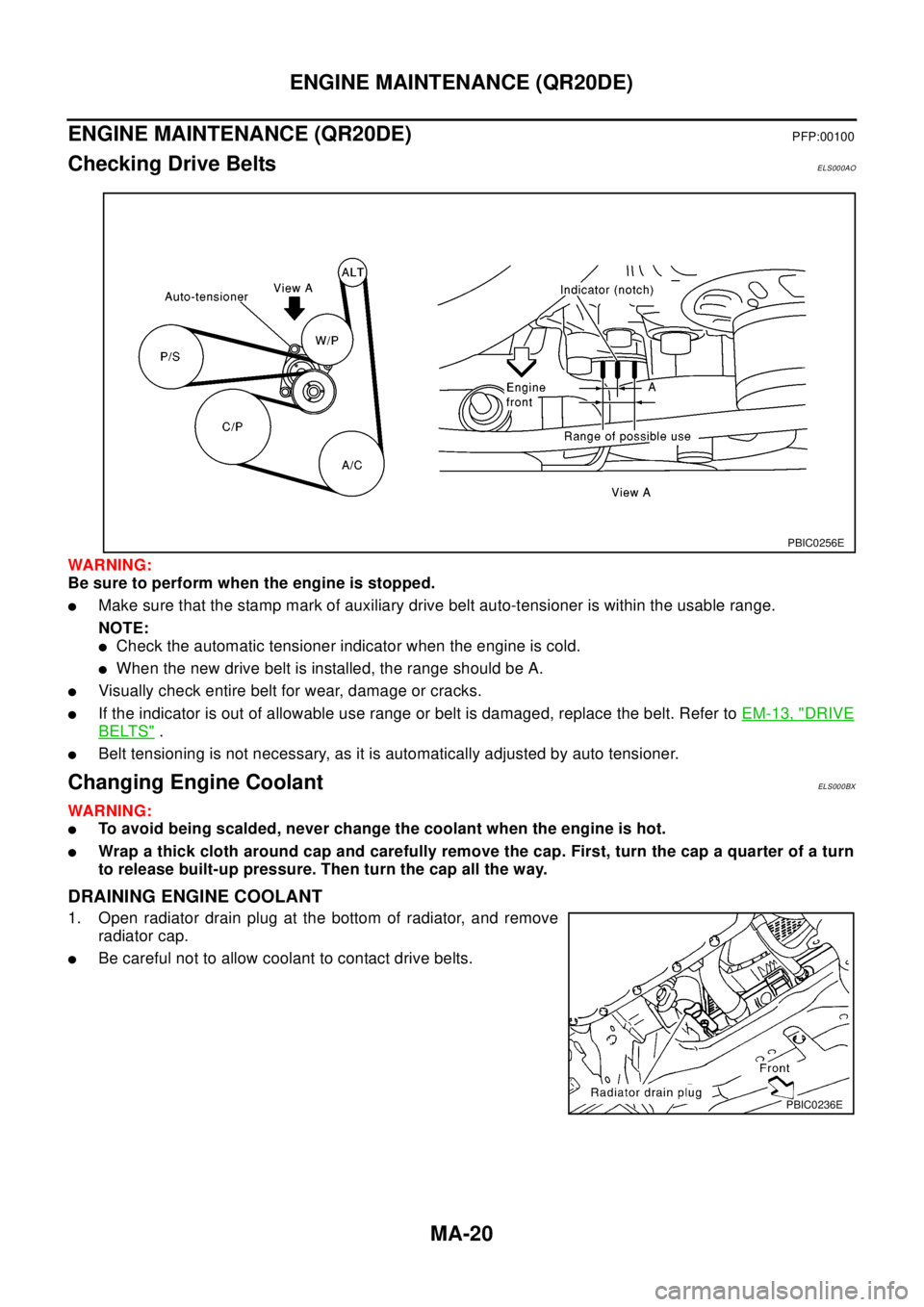
MA-20
ENGINE MAINTENANCE (QR20DE)
ENGINE MAINTENANCE (QR20DE)
PFP:00100
Checking Drive BeltsELS000AO
WAR NIN G:
Be sure to perform when the engine is stopped.
lMake sure that the stamp mark of auxiliary drive belt auto-tensioner is within the usable range.
NOTE:
lCheck the automatic tensioner indicator when the engine is cold.
lWhen the new drive belt is installed, the range should be A.
lVisually check entire belt for wear, damage or cracks.
lIf the indicator is out of allowable use range or belt is damaged, replace the belt. Refer toEM-13, "DRIVE
BELTS".
lBelt tensioning is not necessary, as it is automatically adjusted by auto tensioner.
Changing Engine CoolantELS000BX
WAR NIN G:
lTo avoid being scalded, never change the coolant when the engine is hot.
lWrap a thick cloth around cap and carefully remove the cap. First, turn the cap a quarter of a turn
to release built-up pressure. Then turn the cap all the way.
DRAINING ENGINE COOLANT
1. Open radiator drain plug at the bottom of radiator, and remove
radiator cap.
lBe careful not to allow coolant to contact drive belts.
PBIC0256E
PBIC0236E
Page 2513 of 3066
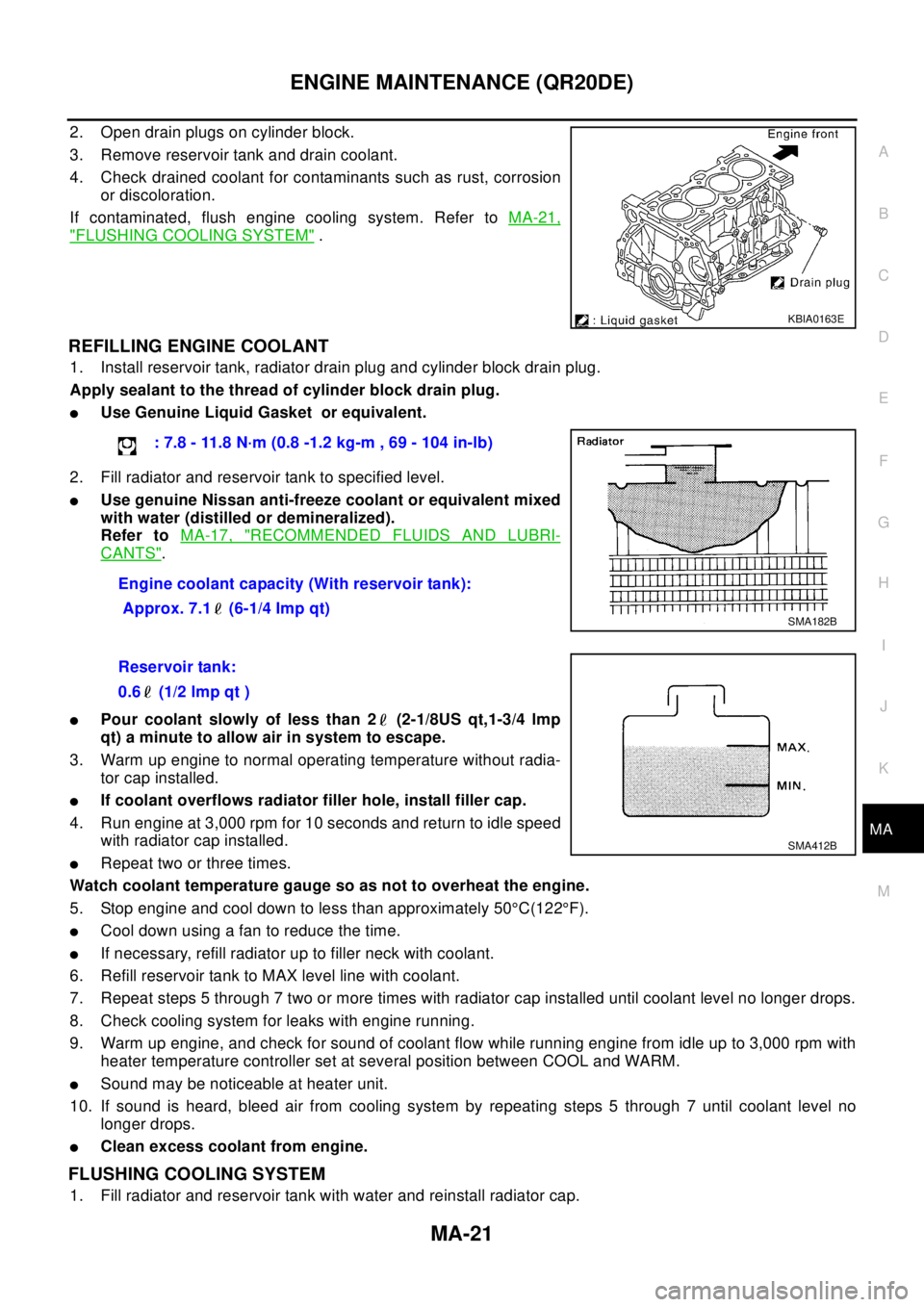
ENGINE MAINTENANCE (QR20DE)
MA-21
C
D
E
F
G
H
I
J
K
MA
B
MA
2. Open drain plugs on cylinder block.
3. Remove reservoir tank and drain coolant.
4. Check drained coolant for contaminants such as rust, corrosion
or discoloration.
If contaminated, flush engine cooling system. Refer toMA-21,
"FLUSHING COOLING SYSTEM".
REFILLING ENGINE COOLANT
1. Install reservoir tank, radiator drain plug and cylinder block drain plug.
Apply sealant to the thread of cylinder block drain plug.
lUse Genuine Liquid Gasket or equivalent.
2. Fill radiator and reservoir tank to specified level.
lUse genuine Nissan anti-freeze coolant or equivalent mixed
with water (distilled or demineralized).
Refer toMA-17, "
RECOMMENDED FLUIDS AND LUBRI-
CANTS".
lPour coolant slowly of less than 2 (2-1/8US qt,1-3/4 lmp
qt) a minute to allow air in system to escape.
3. Warm up engine to normal operating temperature without radia-
tor cap installed.
lIf coolant overflows radiator filler hole, install filler cap.
4. Run engine at 3,000 rpm for 10 seconds and return to idle speed
with radiator cap installed.
lRepeat two or three times.
Watch coolant temperature gauge so as not to overheat the engine.
5. Stop engine and cool down to less than approximately 50°C(122°F).
lCool down using a fan to reduce the time.
lIf necessary, refill radiator up to filler neck with coolant.
6. Refill reservoir tank to MAX level line with coolant.
7. Repeat steps 5 through 7 two or more times with radiator cap installed until coolant level no longer drops.
8. Check cooling system for leaks with engine running.
9. Warm up engine, and check for sound of coolant flow while running engine from idle up to 3,000 rpm with
heater temperature controller set at several position between COOL and WARM.
lSound may be noticeable at heater unit.
10. If sound is heard, bleed air from cooling system by repeating steps 5 through 7 until coolant level no
longer drops.
lClean excess coolant from engine.
FLUSHING COOLING SYSTEM
1. Fill radiator and reservoir tank with water and reinstall radiator cap.
KBIA0163E
: 7.8 - 11.8 N·m (0.8 -1.2 kg-m , 69 - 104 in-lb)
Engine coolant capacity (With reservoir tank):
Approx. 7.1 (6-1/4 Imp qt)
SMA182B
Reservoir tank:
0.6 (1/2 lmp qt )
SMA412B
Page 2514 of 3066
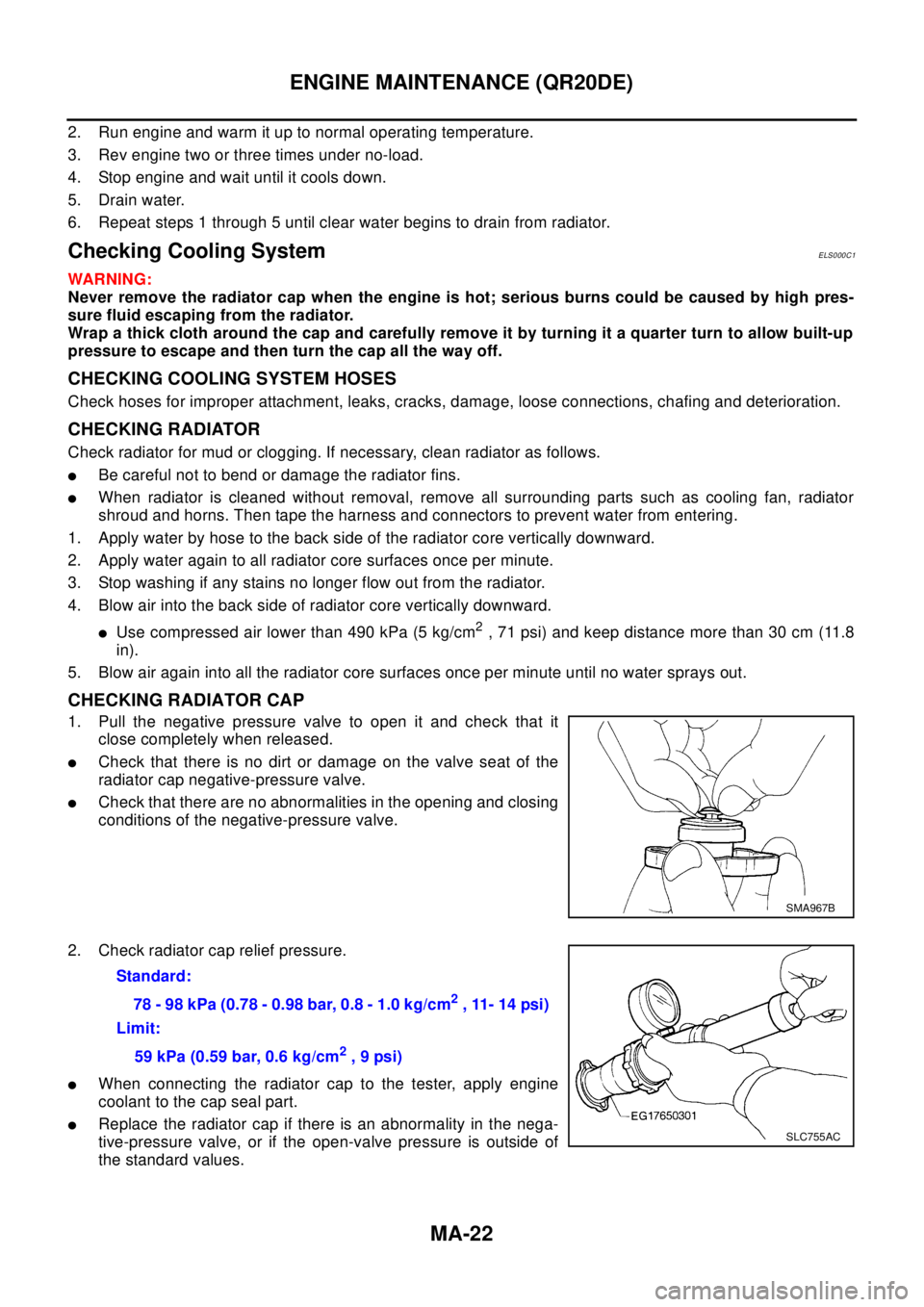
MA-22
ENGINE MAINTENANCE (QR20DE)
2. Run engine and warm it up to normal operating temperature.
3. Rev engine two or three times under no-load.
4. Stop engine and wait until it cools down.
5. Drain water.
6. Repeat steps 1 through 5 until clear water begins to drain from radiator.
Checking Cooling SystemELS000C1
WAR NIN G:
Never remove the radiator cap when the engine is hot; serious burns could be caused by high pres-
sure fluid escaping from the radiator.
Wrap a thick cloth around the cap and carefully remove it by turning it a quarter turn to allow built-up
pressure to escape and then turn the cap all the way off.
CHECKING COOLING SYSTEM HOSES
Check hoses for improper attachment, leaks, cracks, damage, loose connections, chafing and deterioration.
CHECKING RADIATOR
Check radiator for mud or clogging. If necessary, clean radiator as follows.
lBe careful not to bend or damage the radiator fins.
lWhen radiator is cleaned without removal, remove all surrounding parts such as cooling fan, radiator
shroud and horns. Then tape the harness and connectors to prevent water from entering.
1. Apply water by hose to the back side of the radiator core vertically downward.
2. Apply water again to all radiator core surfaces once per minute.
3. Stop washing if any stains no longer flow out from the radiator.
4. Blow air into the back side of radiator core vertically downward.
lUsecompressedairlowerthan490kPa(5kg/cm2, 71 psi) and keep distance more than 30 cm (11.8
in).
5. Blow air again into all the radiator core surfaces once per minute until no water sprays out.
CHECKING RADIATOR CAP
1. Pull the negative pressure valve to open it and check that it
close completely when released.
lCheck that there is no dirt or damage on the valve seat of the
radiator cap negative-pressure valve.
lCheck that there are no abnormalities in the opening and closing
conditions of the negative-pressure valve.
2. Check radiator cap relief pressure.
lWhen connecting the radiator cap to the tester, apply engine
coolant to the cap seal part.
lReplace the radiator cap if there is an abnormality in the nega-
tive-pressure valve, or if the open-valve pressure is outside of
the standard values.
SMA967B
Standard:
78-98kPa(0.78-0.98bar,0.8-1.0kg/cm
2, 11- 14 psi)
Limit:
59 kPa (0.59 bar, 0.6 kg/cm
2,9psi)
SLC755AC
Page 2515 of 3066

ENGINE MAINTENANCE (QR20DE)
MA-23
C
D
E
F
G
H
I
J
K
MA
B
MA
CHECKING COOLING SYSTEM FOR LEAKS
lTo check for leakage, apply pressure to the cooling system with
atester.
WA RN ING:
Never remove the radiator cap when the engine is hot. Serious
burns could occur from high pressure coolant escaping from
the radiator.
CAUTION:
Higher pressure than specified may cause radiator damage.
Checking Fuel LinesELS000AQ
Inspect fuel lines, filler cap and tank for improper attachment, leaks,
cracks, damage, loose connections, chafing or deterioration. If nec-
essary, repair or replace faulty parts.
CAUTION:
Tighten high-pressure rubber hose clamp so that clamp end is 3 mm (0.12 in) from hose end.
Tightening torque specifications are the same for all rubber hose clamps.
Ensure that screw does not contact adjacent parts.
Changing Air Cleaner FilterELS000AR
VISCOUS PAPER TYPE
The viscous paper type filter does not need cleaning.Testing pressure:
157 kPa (1.57 bar, 1.6 kg/cm
2,23psi)
SLC756AA
SMA803A
SMA037D
Page 2516 of 3066
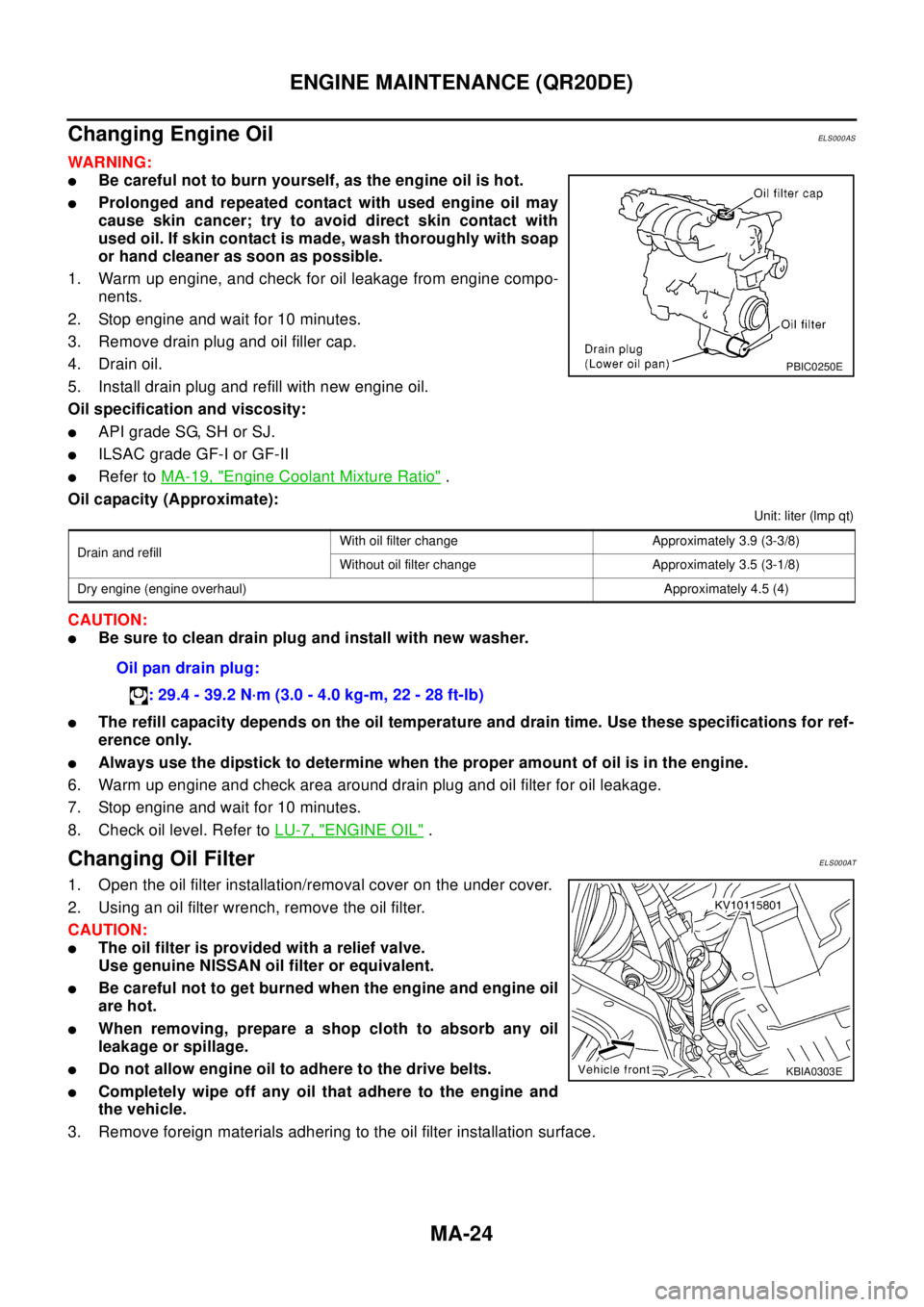
MA-24
ENGINE MAINTENANCE (QR20DE)
Changing Engine Oil
ELS000AS
WAR NIN G:
lBe careful not to burn yourself, as the engine oil is hot.
lProlonged and repeated contact with used engine oil may
cause skin cancer; try to avoid direct skin contact with
used oil. If skin contact is made, wash thoroughly with soap
or hand cleaner as soon as possible.
1. Warm up engine, and check for oil leakage from engine compo-
nents.
2. Stop engine and wait for 10 minutes.
3. Remove drain plug and oil filler cap.
4. Drain oil.
5. Install drain plug and refill with new engine oil.
Oil specification and viscosity:
lAPI grade SG, SH or SJ.
lILSAC grade GF-I or GF-II
lRefer toMA-19, "Engine Coolant Mixture Ratio".
Oil capacity (Approximate):
Unit: liter (lmp qt)
CAUTION:
lBe sure to clean drain plug and install with new washer.
lThe refill capacity depends on the oil temperature and drain time. Use these specifications for ref-
erence only.
lAlways use the dipstick to determine when the proper amount of oil is in the engine.
6. Warm up engine and check area around drain plug and oil filter for oil leakage.
7. Stop engine and wait for 10 minutes.
8. Check oil level. Refer toLU-7, "
ENGINE OIL".
Changing Oil FilterELS000AT
1. Open the oil filter installation/removal cover on the under cover.
2. Using an oil filter wrench, remove the oil filter.
CAUTION:
lThe oil filter is provided with a relief valve.
Use genuine NISSAN oil filter or equivalent.
lBe careful not to get burned when the engine and engine oil
are hot.
lWhen removing, prepare a shop cloth to absorb any oil
leakage or spillage.
lDo not allow engine oil to adhere to the drive belts.
lCompletely wipe off any oil that adhere to the engine and
the vehicle.
3. Remove foreign materials adhering to the oil filter installation surface.
PBIC0250E
Drain and refillWith oil filter change Approximately 3.9 (3-3/8)
Without oil filter change Approximately 3.5 (3-1/8)
Dry engine (engine overhaul) Approximately 4.5 (4)
Oil pan drain plug:
: 29.4 - 39.2 N·m (3.0 - 4.0 kg-m, 22 - 28 ft-lb)
KBIA0303E
Page 2517 of 3066
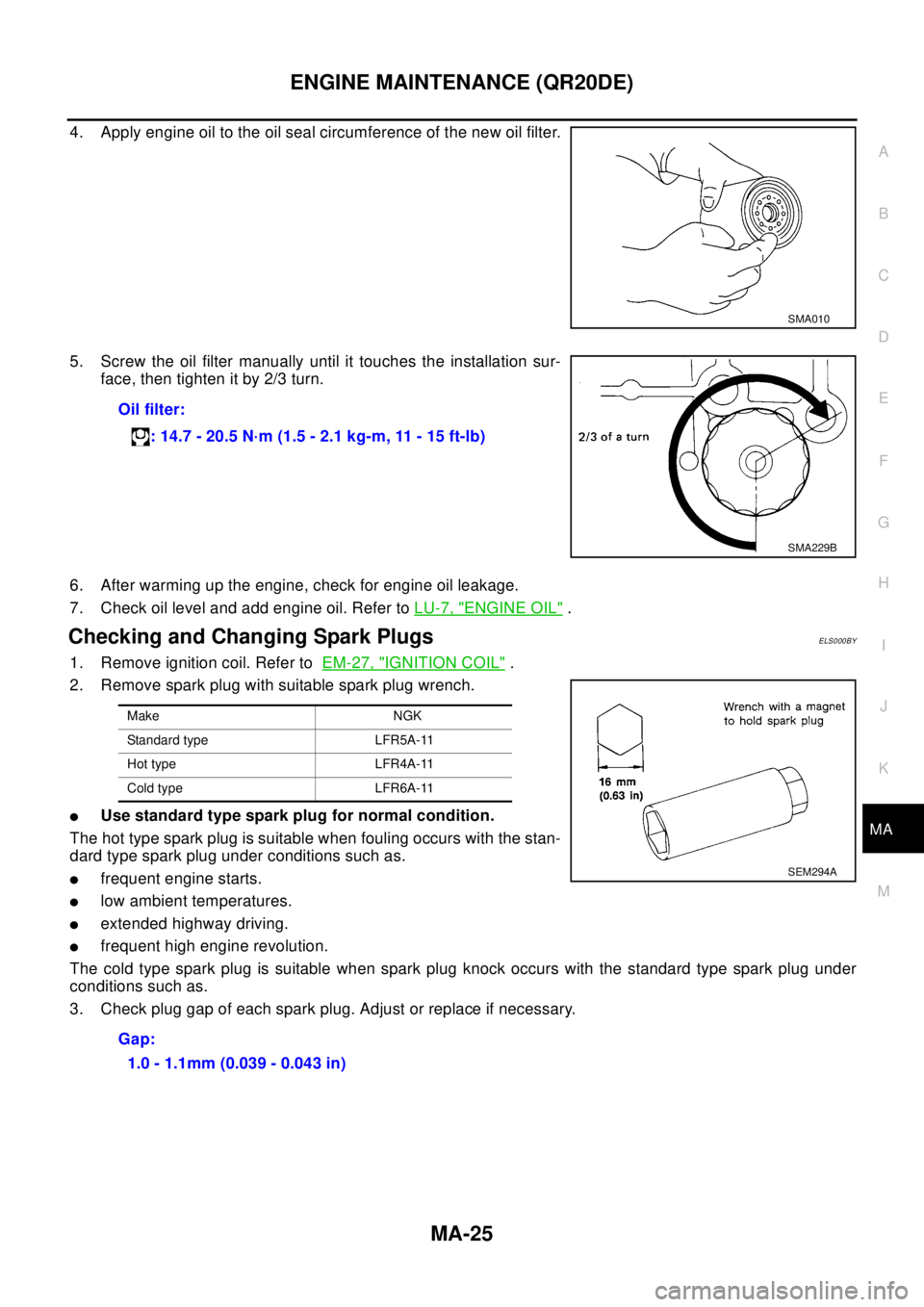
ENGINE MAINTENANCE (QR20DE)
MA-25
C
D
E
F
G
H
I
J
K
MA
B
MA
4. Apply engine oil to the oil seal circumference of the new oil filter.
5. Screw the oil filter manually until it touches the installation sur-
face, then tighten it by 2/3 turn.
6. After warming up the engine, check for engine oil leakage.
7. Check oil level and add engine oil. Refer toLU-7, "
ENGINE OIL".
Checking and Changing Spark PlugsELS000BY
1. Remove ignition coil. Refer toEM-27, "IGNITION COIL".
2. Remove spark plug with suitable spark plug wrench.
lUse standard type spark plug for normal condition.
The hot type spark plug is suitable when fouling occurs with the stan-
dard type spark plug under conditions such as.
lfrequent engine starts.
llow ambient temperatures.
lextended highway driving.
lfrequent high engine revolution.
The cold type spark plug is suitable when spark plug knock occurs with the standard type spark plug under
conditions such as.
3. Check plug gap of each spark plug. Adjust or replace if necessary.
SMA010
Oil filter:
: 14.7 - 20.5 N·m (1.5 - 2.1 kg-m, 11 - 15 ft-lb)
SMA229B
Make NGK
Standard type LFR5A-11
Hot type LFR4A-11
Cold type LFR6A-11
Gap:
1.0 - 1.1mm (0.039 - 0.043 in)
SEM294A
Page 2518 of 3066
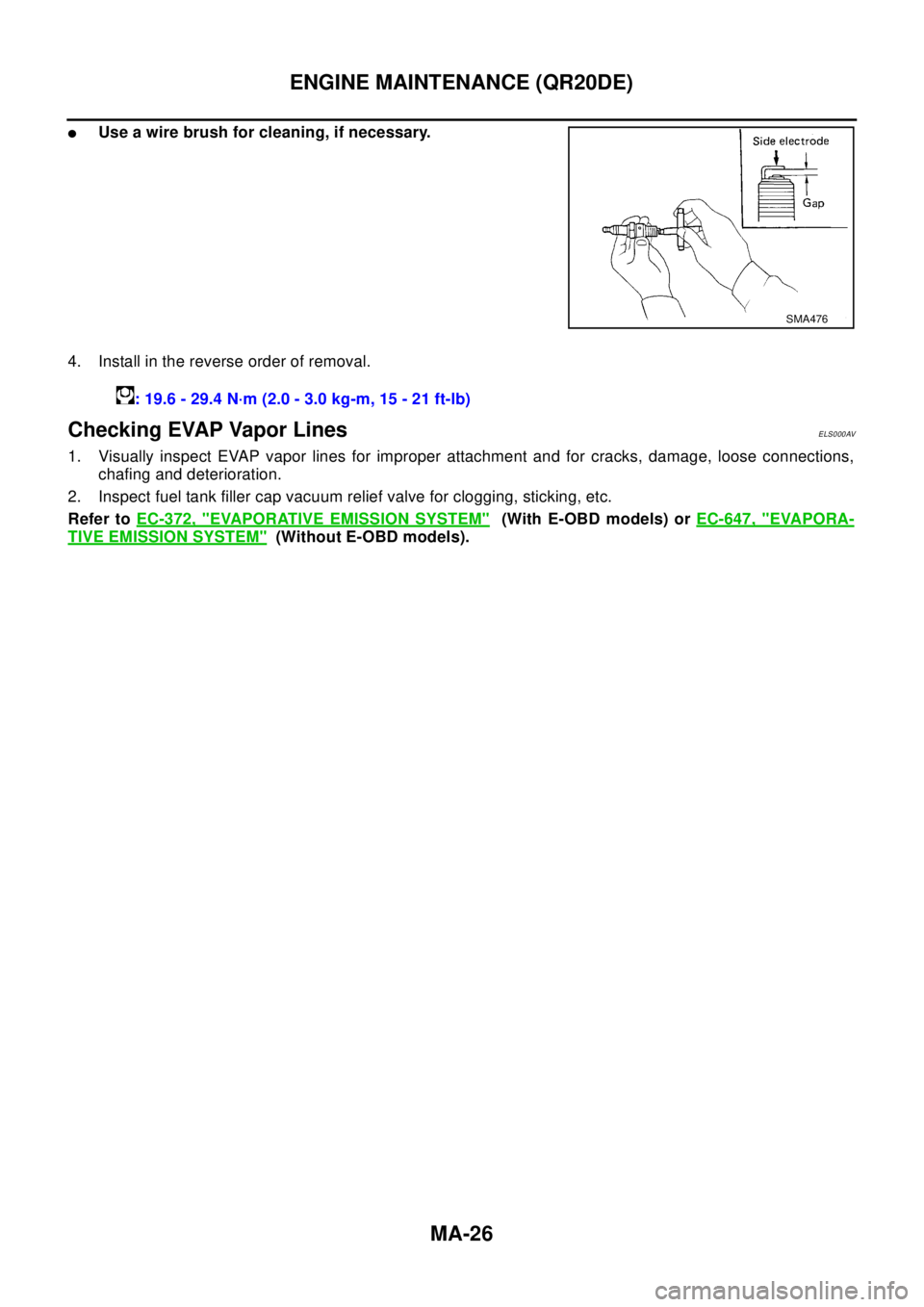
MA-26
ENGINE MAINTENANCE (QR20DE)
lUse a wire brush for cleaning, if necessary.
4. Install in the reverse order of removal.
Checking EVAP Vapor LinesELS000AV
1. Visually inspect EVAP vapor lines for improper attachment and for cracks, damage, loose connections,
chafing and deterioration.
2. Inspect fuel tank filler cap vacuum relief valve for clogging, sticking, etc.
Refer toEC-372, "
EVAPORATIVE EMISSION SYSTEM"(With E-OBD models) orEC-647, "EVAPORA-
TIVE EMISSION SYSTEM"(Without E-OBD models).
SMA476
: 19.6 - 29.4 N·m (2.0 - 3.0 kg-m, 15 - 21 ft-lb)
Page 2519 of 3066
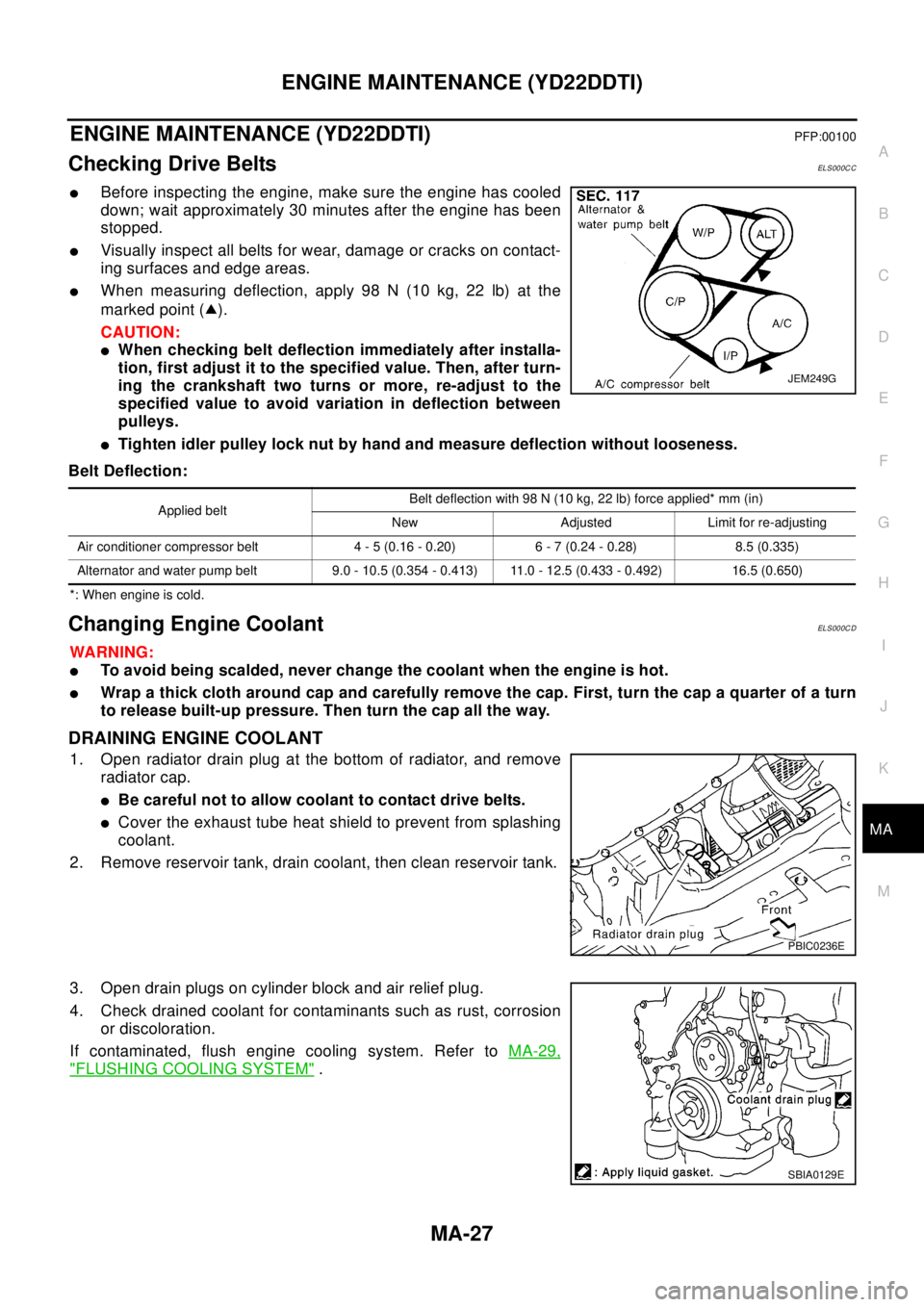
ENGINE MAINTENANCE (YD22DDTI)
MA-27
C
D
E
F
G
H
I
J
K
MA
B
MA
ENGINE MAINTENANCE (YD22DDTI)PFP:00100
Checking Drive BeltsEL S00 0C C
lBefore inspecting the engine, make sure the engine has cooled
down; wait approximately 30 minutes after the engine has been
stopped.
lVisually inspect all belts for wear, damage or cracks on contact-
ing surfaces and edge areas.
lWhen measuring deflection, apply 98 N (10 kg, 22 lb) at the
marked point ( ).
CAUTION:
lWhen checking belt deflection immediately after installa-
tion, first adjust it to the specified value. Then, after turn-
ing the crankshaft two turns or more, re-adjust to the
specified value to avoid variation in deflection between
pulleys.
lTighten idler pulley lock nut by hand and measure deflection without looseness.
Belt Deflection:
*: When engine is cold.
Changing Engine CoolantEL S00 0C D
WA RN ING:
lTo avoid being scalded, never change the coolant when the engine is hot.
lWrap a thick cloth around cap and carefully remove the cap. First, turn the cap a quarter of a turn
to release built-up pressure. Then turn the cap all the way.
DRAINING ENGINE COOLANT
1. Open radiator drain plug at the bottom of radiator, and remove
radiator cap.
lBe careful not to allow coolant to contact drive belts.
lCover the exhaust tube heat shield to prevent from splashing
coolant.
2. Remove reservoir tank, drain coolant, then clean reservoir tank.
3. Open drain plugs on cylinder block and air relief plug.
4. Check drained coolant for contaminants such as rust, corrosion
or discoloration.
If contaminated, flush engine cooling system. Refer toMA-29,
"FLUSHING COOLING SYSTEM".
JEM249G
Applied beltBelt deflection with 98 N (10 kg, 22 lb) force applied* mm (in)
New Adjusted Limit for re-adjusting
Air conditioner compressor belt 4 - 5 (0.16 - 0.20) 6 - 7 (0.24 - 0.28) 8.5 (0.335)
Alternator and water pump belt 9.0 - 10.5 (0.354 - 0.413) 11.0 - 12.5 (0.433 - 0.492) 16.5 (0.650)
PBIC0236E
SBIA0129E
Page 2520 of 3066
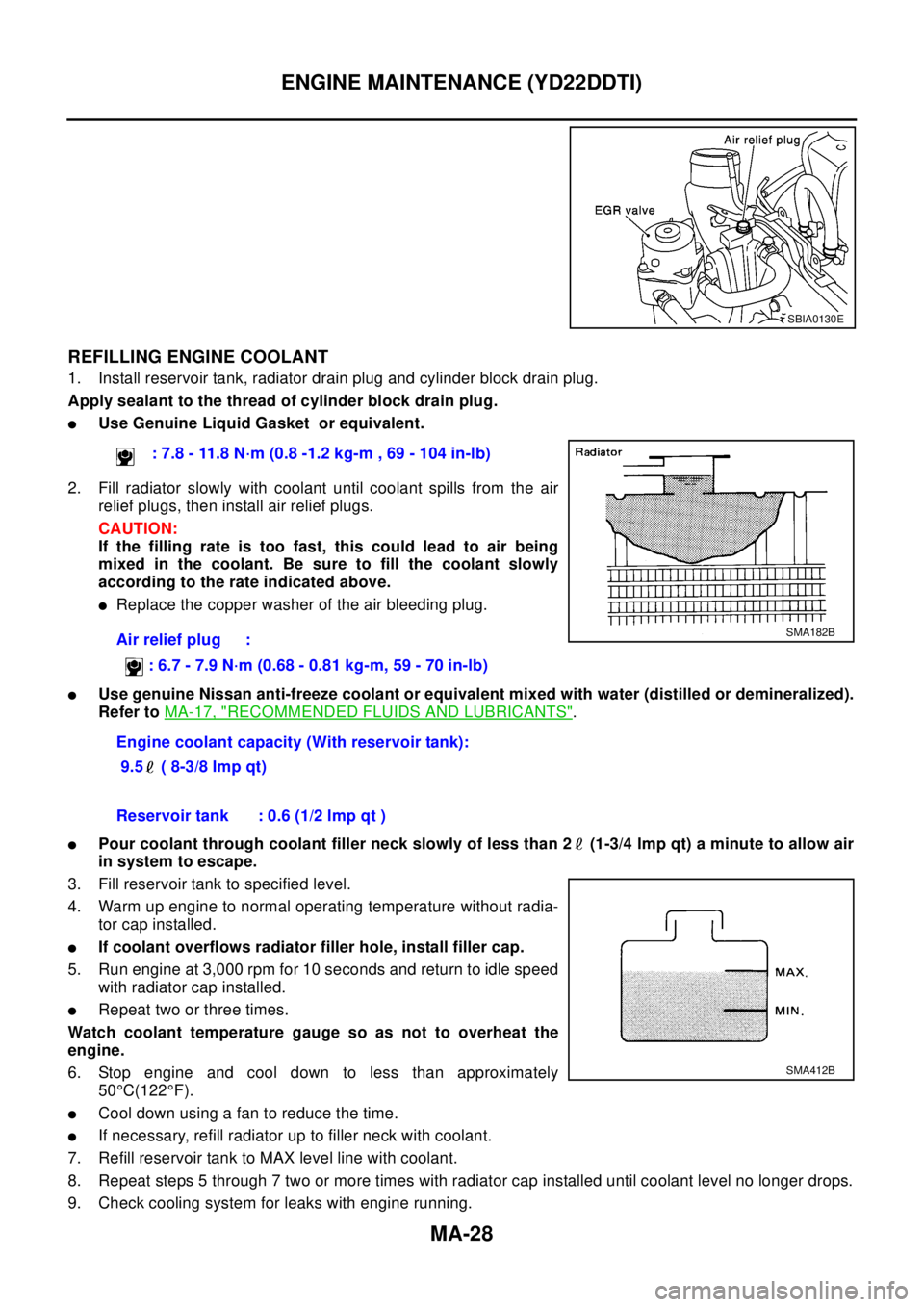
MA-28
ENGINE MAINTENANCE (YD22DDTI)
REFILLING ENGINE COOLANT
1. Install reservoir tank, radiator drain plug and cylinder block drain plug.
Apply sealant to the thread of cylinder block drain plug.
lUse Genuine Liquid Gasket or equivalent.
2. Fill radiator slowly with coolant until coolant spills from the air
relief plugs, then install air relief plugs.
CAUTION:
If the filling rate is too fast, this could lead to air being
mixed in the coolant. Be sure to fill the coolant slowly
according to the rate indicated above.
lReplace the copper washer of the air bleeding plug.
lUse genuine Nissan anti-freeze coolant or equivalent mixed with water (distilled or demineralized).
Refer toMA-17, "
RECOMMENDED FLUIDS AND LUBRICANTS".
lPour coolant through coolant filler neck slowly of less than 2 (1-3/4 lmp qt) a minute to allow air
in system to escape.
3. Fill reservoir tank to specified level.
4. Warm up engine to normal operating temperature without radia-
tor cap installed.
lIf coolant overflows radiator filler hole, install filler cap.
5. Run engine at 3,000 rpm for 10 seconds and return to idle speed
with radiator cap installed.
lRepeat two or three times.
Watch coolant temperature gauge so as not to overheat the
engine.
6. Stop engine and cool down to less than approximately
50°C(122°F).
lCool down using a fan to reduce the time.
lIf necessary, refill radiator up to filler neck with coolant.
7. Refill reservoir tank to MAX level line with coolant.
8. Repeat steps 5 through 7 two or more times with radiator cap installed until coolant level no longer drops.
9. Check cooling system for leaks with engine running.
SBIA0130E
: 7.8 - 11.8 N·m (0.8 -1.2 kg-m , 69 - 104 in-lb)
Air relief plug :
:6.7-7.9N·m(0.68-0.81kg-m,59-70in-lb)
Engine coolant capacity (With reservoir tank):
9.5 ( 8-3/8 Imp qt)
SMA182B
Reservoir tank : 0.6 (1/2 lmp qt )
SMA412B